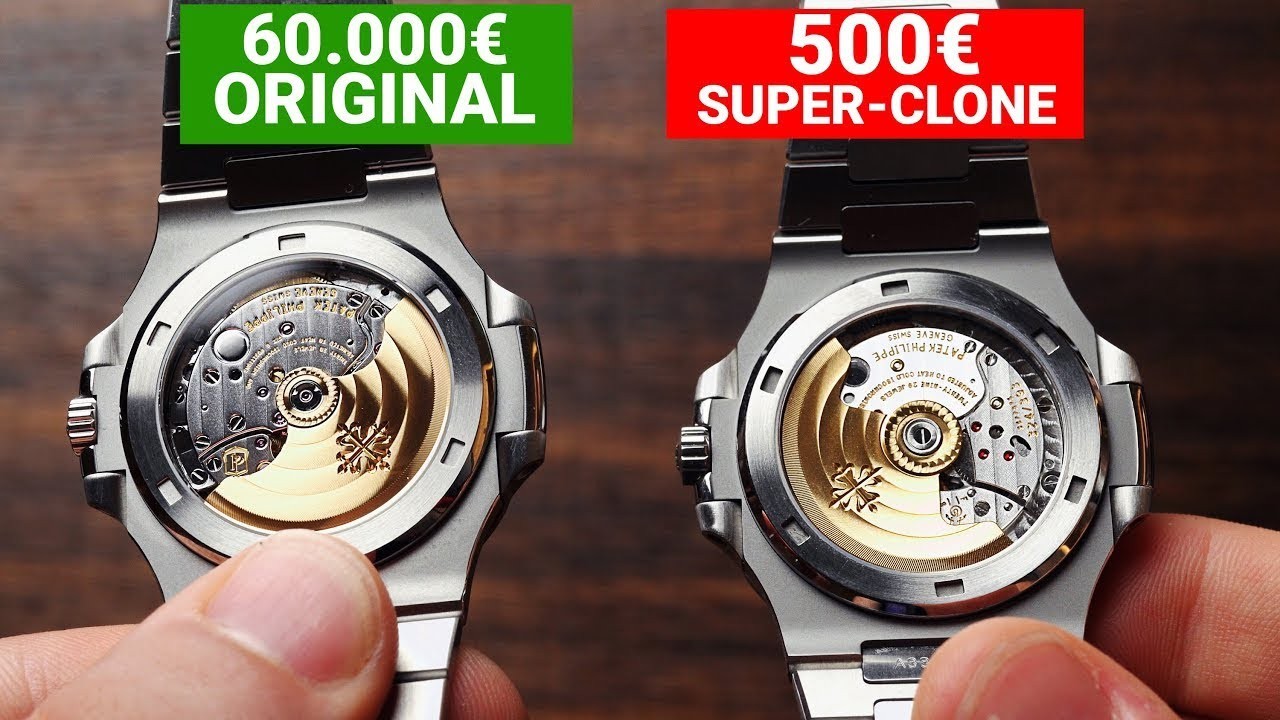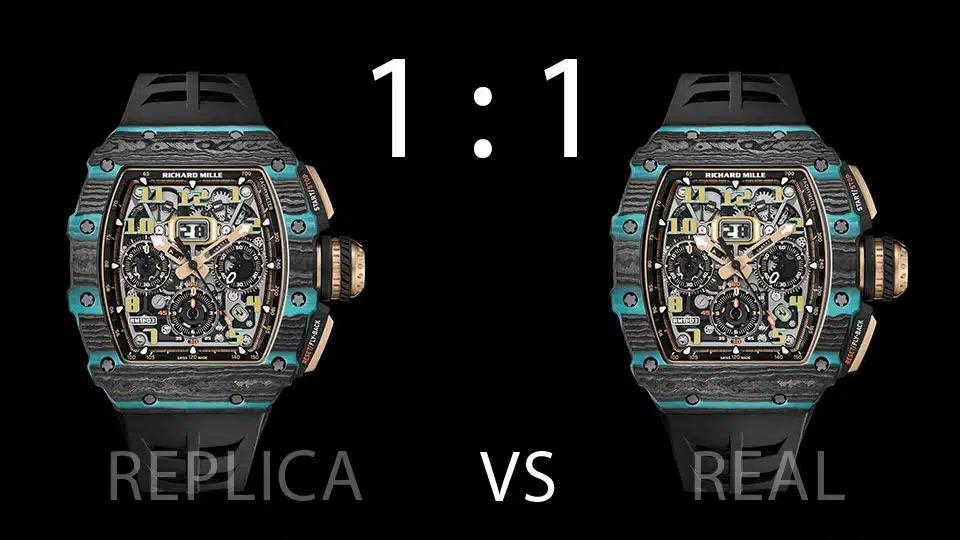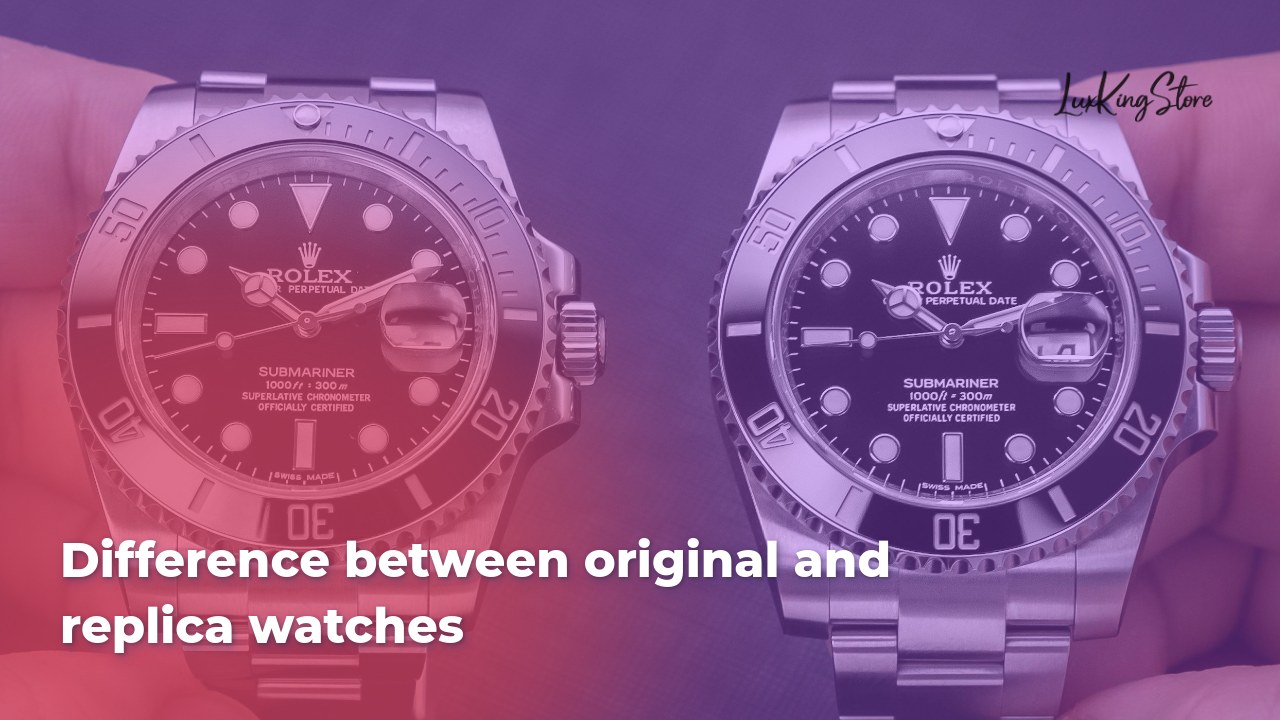Difference Between Original and Replica Watches
Difference Between Original and Replica Watches
When it comes to watches, the distinction between originals and replicas can be quite alluring and perplexing at the same time. Many people admire high-end timepieces for their exquisite craftsmanship and prestige, but not everyone can afford the price tag that comes with genuine luxury brands. This leads to the rise of replica watches, which aim to replicate the look of authentic pieces while offering a more budget-friendly option. However, the question remains: What really separates these two types of watches beyond just price? Is it merely the origin, or are there deeper, more significant differences worth exploring? Difference Between Original and Replica Watches: In this article, we will delve into what defines original watches, explore the characteristics of replicas, provide a comprehensive quality comparison, analyze pricing, and reveal the investment value of owning an authentic timepiece.
What Defines Original Watches?
Original watches, often referred to as authentic or genuine watches, are products of reputable brands celebrated for their craftsmanship and elegance. The core aspects that characterize original watches can be summarized as follows:
- Craftsmanship: Genuine watches are epitomes of meticulous artistry, where skilled artisans handcraft each component. The assembly involves intricate detailing, ensuring precision in every aspect from case finishing to dials and engravings. This level of craftsmanship is a hallmark of brands like Rolex and Patek Philippe, where being well-versed in watchmaking techniques has been part of their heritage for decades.
- Materials: Authentic timepieces are made using high-quality materials, often scientifically engineered for durability and aesthetic appeal. For instance, many luxury watches use 904L stainless steel, which is more resistant to corrosion than standard stainless steel. Additionally, features like sapphire crystal provide scratch resistance, which is vital for maintaining the watch’s pristine appearance over time.
- Movement: The movement, or the mechanism that powers the watch, is one of the most critical differentiators between original and replica watches. High-end brands tend to develop proprietary movements, ensuring superior accuracy and smooth operation. With automatic models, you’ll notice the smooth sweeping of the second hand, a true sign of quality contrasting the ticking motion of lesser replicas.
- Brand Value: Original luxury watches are steeped in tradition and reputation, enhancing their value as collectibles or investment pieces. Brands like Audemars Piguet and Omega have established legacies that not only signify quality but also symbolize status. Ownership of such timepieces is often seen as a reflection of personal achievement and style.
| **Attribute** | **Original Watches** | **Replica Watches** |
|---|---|---|
| **Craftsmanship** | Meticulous assembly by artisans | Mass-produced, often flawed details |
| **Materials** | High-grade metals, sapphire glass | Cheap materials, plastic/glass variants |
| **Movement** | Proprietary, smooth operation | Standard movements, ticking sound |
| **Brand Value** | Historical, high resale value | Lacking brand heritage, little to no value |
In summary, original watches encapsulate not only physical attributes but also the brand’s legacy and craftsmanship that leads to their high market value.
Characteristics of Replica Watches
Replica watches seek to emulate the aesthetic features of original timepieces but often fall short in several critical areas. While they may superficially resemble their more costly counterparts, their underlying quality, materials, and craftsmanship typically lack authenticity. Here are some defining characteristics of replica watches:
- Quality of Materials: Replicas often employ cheap alternatives to genuine materials, sacrificing durability and longevity. For example, instead of the 904L stainless steel used in authentic Rolex watches, replicas may use standard stainless steel, which does not have the same resistant properties or shine.
- Craftsmanship: The detailing in replica watches is usually noticeably less refined. Close examination might reveal flaws in engravings, dial textures, and even the watch casing. While original pieces are meticulously crafted, replicas often exhibit visible shortcuts to keep costs down, leading to an overall inferior finish.
- Movement Quality: Most replicas contain standard quartz movements rather than the intricate mechanisms seen in high-end watches. These movements prioritize looks over functionality, often resulting in less accurate timekeeping. Many users are disappointed to notice that the once-seamless motion of the second hand turns into a jerky ticking movement instead.
- Brand Impersonation Risks: Beyond the aesthetic, possessing a replica can carry legal and ethical implications. Many countries have stringent laws against counterfeit goods, and wearing replicas can not only tarnish personal reputation but also lead to legal consequences.
| **Attribute** | **Replica Watches** |
|---|---|
| **Quality of Materials** | Inferior metals and glass |
| **Craftsmanship** | Flawed details, mass production |
| **Movement Quality** | Basic, prioritizing appearance |
| **Legal Risks** | Counterfeiting consequences |
Ultimately, while replicas may present an enticing visual appeal, they frequently falter in terms of quality and reliability, falling short of the expectations set by truly authentic timepieces.

Quality Comparison: Original vs. Replica
The quality of a watch can often define its appeal and longevity in the marketplace. When comparing original watches to their replica counterparts, several factors help paint a clearer picture of their qualitative differences.
1. Craftsmanship
Original luxury watches are products of intricate craftsmanship that combines art and science. Each component is designed and assembled with precision, ensuring that all aspects work harmoniously. The artisans behind these creations typically undergo years of rigorous training. In contrast, replicas often lack this level of artisanal expertise, leading to a product that may look good at first glance but does not perform reliably over time.
2. Durability
Authentic watches are made from premium quality materials designed to withstand daily wear and tear. For instance, a genuine luxury watch’s case may be crafted with reinforced materials, while the glass is often hardened sapphire, making it far less susceptible to scratches and breakage. Replicas fail to offer such resilience, with many featuring cheap plastics and standard mineral glass that can deteriorate quickly and affect the aesthetic appeal.
3. Precision
One of the trademarks of a genuine luxury watch is its precise movement. Swiss watches are renowned for their sophistication, typically featuring meticulous movements that provide exceptional accuracy. In contrast, most replica watches contain basic, mass-produced movements that prioritize superficial appearances over reliability.
4. Documentation and Authenticity
Original watches come with proper documentation, including warranties and authentication papers, ensuring consumers are purchasing genuine products. Replicas are typically sold without any such certification, consequently affecting their perceived value and resale potential.
| **Quality Attribute** | **Original Watches** | **Replica Watches** |
|---|---|---|
| **Craftsmanship** | Artisan-crafted | Mass-produced |
| **Durability** | High-grade materials | Inferior components |
| **Precision** | Superior accuracy | Basic, unreliable |
| **Documentation** | Includes certificates | No verification |
In conclusion, original watches showcase exceptional quality driven by years of expertise, whereas replicas often prioritize aesthetics without integrity.
Price Analysis: Original and Replica Watches
The price tag on a watch often serves as a significant determinant in a buyer’s choice. Original luxury watches command a high price due to their unparalleled craftsmanship, materials, and brand prestige. For example, an authentic Rolex can easily cost anywhere from $5,000 to $50,000, depending on the model and features it offers, making them not just watches but investments.
In stark contrast, replica watches cater to a more budget-conscious demographic. Prices for these timepieces can range from a mere $200 to around $1,500 for high-quality replicas, making them highly accessible. However, even the highest quality of replicas pales compared to their authentic counterparts.
Price Breakdown
| **Brand/Model** | **Original Price** | **Replica Price** |
|---|---|---|
| **Rolex Submariner** | $8,000 – $12,000 | $300 – $600 |
| **Omega Speedmaster** | $5,000 – $10,000 | $250 – $700 |
| **Patek Philippe Nautilus** | $30,000 – $100,000 | $1,000 – $1,500 |
Key Considerations:
- Resale Value: Original watches often appreciate in value over time thanks to brand heritage and demand. In contrast, replicas typically cannot be resold for substantial amounts, making them less viable as long-term investments.
- Perception: Owning an original watch generally conveys status and achievement, while replicas can sometimes carry stigma and legal implications.
Thus, while both options present financial perspectives for the potential buyer, their values construct vastly different experiences.

Investment Value of Original Watches
Investing in original watches is often seen as both a personal and financial decision. The market for luxury timepieces consistently shows trends of appreciation over time, making these watches not just accessories but a part of one’s investment portfolio.
1. Appreciation Potential
High-quality brands such as Rolex, Patek Philippe, and Audemars Piguet have established endings of valuable collector’s items, especially limited editions and vintage pieces. For instance, certain vintage Rolex models have successfully sold for tens of thousands of dollars at auction, reflecting their investment potential.
2. Market Demand
The desirability of luxury timepieces continues to grow, fueled by both traditional collectors and a younger audience. As demand increases, the market witnesses a corresponding rise in prices, particularly for models with unique craftsmanship and materials.
3. Rarity and Condition
The rarity of a particular model combined with its condition significantly impacts its investment value. Models that were produced in limited runs, or exhibit impeccable condition with all original parts intact, fetch better prices at resale.
4. Included Warranty and Service
Original luxury watches often come with warranties and service packages from authorized dealers. This not only ensures that the watch is maintained adequately but also maintains its resale value. Replicas, lacking such assurances, typically have a much shorter lifespan, rendering them less valuable in the long run.
| **Investment Factors** | **Original Watches** | **Replica Watches** |
|---|---|---|
| **Market Demand** | Strong, appreciates over time | Minimal value retention |
| **Rarity** | Limited editions highly sought | Often mass-produced |
| **Condition** | Maintains value, can increase | Deteriorates quickly |
| **Service/Warranty** | Warranties provided | No formal warranty |
In summary, original watches not only offer aesthetic pleasure but also present a solid investment potential for discerning collectors or enthusiasts.
Durability: How Originals and Replicas Measure Up
When considering longevity, durability often serves as a critical characteristic influencing purchasing decisions. Durability fundamentally affects both the function of the watch and the value it retains over time.
Construction:
Original watches utilize high-grade materials engineered for extensive use. For instance, cases crafted from 904L stainless steel resist scratching and corrosion, significantly extending the lifespan of the watch. In contrast, replicas often feature cheaper metals that can corrode or warp with time, losing their aesthetic value.
Testing Standards:
Many original brands subject their watches to rigorous testing to ensure they withstand various conditions be it water resistance or shock resistance. This level of assurance is often lacking in replica watches. Such tests contribute to the reliability and integrity of the watch over years of ownership.
Service and Maintenance:
Original watches are supported by the manufacturer through warranty and service options. Regular maintenance from certified technicians ensures longevity, retaining the watch’s performance and appearance. Replica watches generally do not have this support, often leading to issues that cannot be adequately rectified.
Wear and Tear:
Due to the quality of materials and craftsmanship, original watches often show minimal wear after years of use. Replicas, conversely, frequently display signs of wear sooner than expected.
| **Durability Attributes** | **Original Watches** | **Replica Watches** |
|---|---|---|
| **Material Quality** | Premium, resistant to damage | Cheap, prone to corrosion |
| **Testing** | Rigorous, high standards | Minimal, lacking assurance |
| **Maintenance** | Extensive service options | Little to no support |
| **Aesthetics Over Time** | Long-lasting, retains value | Deteriorates quickly |
Ultimately, when it comes to durability, original watches are engineered to last and endure, while replicas falter significantly under scrutiny.
Brand Recognition: The Impact of Originals vs. Replicas
Brand recognition plays a significant role in elevating the value and desirability of original watches. Established luxury brands have built immense reputations grounded in their history, craftsmanship, and innovation. This aura surrounding their timepieces often underscores the distinction between authentic and replica watches.
Prestige and Status:
Owning an original luxury watch is often interpreted as a reflection of personal achievement and sophistication. High-end brands such as Rolex and Patek Philippe carry a weight of esteem that is challenging for replicas to replicate. The mere presence of such a watch signals success within social contexts and conveys quality.
Brand Loyalty:
Original brands foster a strong sense of loyalty among their consumers. This loyalty arises from the consistent quality, innovative designs, and historical significance attached to their timepieces. Replica brands lack this connection and often fail to cultivate lasting consumer relationships.
Marketing and Heritage:
Authentic brands have immense marketing power that stems from their deep-rooted heritage and narrative. They consistently promote their product’s craftsmanship, exclusivity, and reliability, thus reassuring consumers of their investment. In contrast, replicas commonly rely on imitation of looks and aesthetics rather than the quality narrative that accompanies original pieces.
Perception of Value:
The perception of a brand significantly affects resale values. Original watch brands enjoy significant resale value driven by the strength of brand perception and demand. Replicas, however, due to their lack of authentic pedigree, often struggle to maintain any resale value.
| **Brand Recognition Factors** | **Original Watches** | **Replica Watches** |
|---|---|---|
| **Prestige** | High-status symbols | Often viewed negatively |
| **Consumer Loyalty** | Strong, emotional attachment | Minimal, superficial interest |
| **Heritage** | Rich history and narrative | Lacks true story |
| **Resale Value** | Appreciates over time | Frequently loses value |
In conclusion, the impact of brand recognition is a defining variable in the market of timepieces, setting originals apart from replicas in ways that extend far beyond mere appearance.

Accuracy and Functionality: Original Watches Compared to Replicas
The functionality of a watch is pivotal. When it comes to mechanical accuracy, original watches and replicas diverge significantly.
Precision Engineering:
Authentic luxury watches are engineered with precision in mind. Many high-end models feature intricate mechanical movements, tailored for speed and accuracy that replicate original designs. These watches undergo strict quality control, ensuring they perform flawlessly and maintain time accurately over long periods.
Movement Quality:
The movements in original watches are proprietary creations often showcasing the pinnacle of horological craftsmanship. For instance, brands such as Seiko and Swiss watchmakers continuously innovate to produce exceedingly reliable movements. Conversely, many replicas utilize standard quartz movements or inferior mechanical movements that often lead to inaccuracy and performance issues.
Long-term Functionality:
Authentic watches are designed to last and function optimally for years, often performing consistently and requiring less frequent battery changes or repairs. High-end brands leave a legacy of long-lasting reliability that consumers can depend on. In contrast, replicas may exhibit issues early on and require frequent repairs that often are subpar.
Warranty Commitments:
With original watches often comes a warranty that covers manufacturing defects, allowing owners peace of mind. Conversely, replicas typically lack formal warranty coverage, leading to potential frustrations when failures occur.
| **Accuracy Attributes** | **Original Watches** | **Replica Watches** |
|---|---|---|
| **Precision Engineering** | High-quality, innovative | Standard basic movements |
| **Long-term Functionality** | Reliable, enduring | Often prone to early failure |
| **Warranty Commitments** | Coverage for defects | No formal warranty |
| **Performance Consistency** | Consistent, smooth | Variable, often unsatisfactory |
Thus, accuracy and functionality build larger narratives that separate original watches from their replica counterparts, crucially affecting consumer satisfaction.
Warranty and Service Differences Between Original and Replica Watches
The differences in warranty and service policies between original and replica watches are profound and often influence buyer decisions significantly.
Warranty Coverage:
Original watches generally come with comprehensive warranties, ranging from two to five years, which cover defects in materials and workmanship. This warranty ensures buyers that if any issues arise, they will be handled by authorized dealers, thus providing much-needed peace of mind when investing significant sums.
Conversely, replica watches typically do not come with any warranty, as their manufacturers often do not adhere to the same standards as original brands. If a replica watch fails or malfunctions, repair options are often limited and may involve out-of-pocket expenses without any guarantees.
Authorized Service:
Original watches are serviced by skilled technicians who use genuine parts to maintain the watch’s integrity and performance. Routine servicing conducted by authorized retailers keeps the watch functioning optimally and has the added benefit of preserving its resale value. In stark contrast, replica clocks are typically maintained by third-party technicians, and these services can compromise the watch’s quality.
Overall Value Impact:
The presence of a warranty and reliable service support adds considerable value to authentic watches. Prospective buyers often see these factors as security for their financial investment. With replicas lacking this support, they tend to have a much shorter lifespan, diminishing their overall worth in the marketplace.
| **Warranty and Service Attributes** | **Original Watches** | **Replica Watches** |
|---|---|---|
| **Warranty Coverage** | 2-5 year comprehensive coverage | No warranty offered |
| **Authorized Service** | Skilled technicians, genuine parts | Lacks reliable technicians |
| **Repair Options** | High-quality assistance available | Limited, often costly repairs |
| **Value Impact** | Retains and enhances value | Minimal to no resale value |
In summary, the comprehensive warranty and service policies offered by original watches underscore their value and reliability, setting them apart from the quick-fix nature of replicas.

Frequently Asked Questions (FAQs)
- What is the main difference between original and replica watches?
- The main difference lies in craftsmanship, material quality, movements, and brand value. Original watches are crafted by reputable brands with high standards, while replicas often use cheaper materials and lack authenticity.
- Are original watches worth the investment?
- Yes, original watches from respected brands typically appreciate in value over time, making them not just fashion items but also financial investments.
- Can replica watches accurately tell time?
- While many replica watches can tell time, their accuracy and longevity are often inferior compared to original brands due to lower-quality components and movements.
- Do original watches come with warranties?
- Yes, most original watches come with warranties ranging from 2 to 5 years, covering defects due to poor craftsmanship.
- Can I resell a replica watch?
- Generally, replicas do not hold substantial resale value and are often seen as counterfeit goods, making them difficult to sell legally.
Key Takeaways
- Craftsmanship and Quality: Original watches are meticulously crafted from high-grade materials ensuring longevity, while replicas often lack precision.
- Investment Value: Original watches appreciate over time, making them sound investments, while replicas generally depreciate rapidly.
- Durability and Warranty: Authentic watches come with warranty support and authorized dealer service ensuring robust maintenance, unlike replicas.
- Brand Recognition: Original timepieces carry significant prestige and status, whereas replicas face negative perceptions.
- Accuracy and Functionality: Original watches provide superior movements, ensuring precise timekeeping, whereas replicas may falter in performance.
Conclusion
Ultimately, the choice between original and replica watches can significantly impact consumer satisfaction. While replicas provide a budget-friendly option, they fundamentally lack the quality, craftsmanship, and prestige associated with authentic timepieces. Original watches represent more than mere accessories; they symbolize luxury, heritage, and enduring value. Investing in a genuine watch not only promises superior performance and durability, but it also becomes a meaningful addition to one’s collection a constant reminder of personal achievements. In the watch world, the route you choose to take reflects not just your taste, but your values and aspirations as well.
Google Search Keywords
- original vs replica watches
- watch investment value
- quality difference in watches
- are replica watches worth it
- luxury watch repair and warranty services

